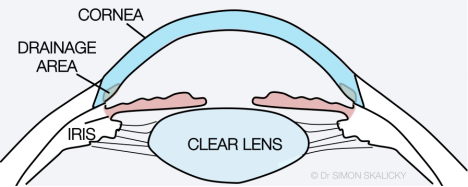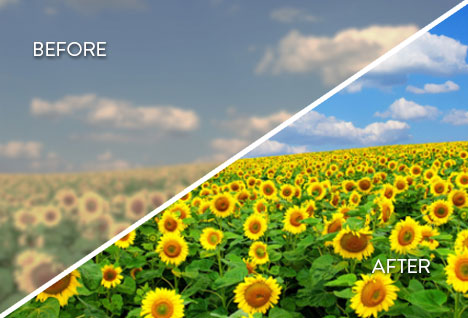What is a Cataract?
The lens is a flexible and transparent structure in the eye that enables the eye to focus clearly on objects at varying distances. A cataract is the clouding of the normally transparent lens. This clouding interferes with light entering the eye, which affects a person’s ability to see clearly. Whilst not a growth, if left untreated, people with cataracts may eventually go blind.
Normal clear lens vs Cataract


What causes a cataract?
Cataracts primarily occur as a natural consequence of ageing. As you age, the lenses in your eyes become less flexible, less transparent and thicker. Ageing will cause protein structures within the lens to disintegrate and clump together, clouding at first small areas within the lens. As the cataract continues to develop, blurring becomes denser. Cataracts blocks the light as it passes through the lens, preventing a sharply defined image from reaching your retina (the part of the eye that produces an image for the brain to interpret). As a result, your vision becomes blurred.
Whilst old age is a leading cause of cataracts, they can be worsened by smoking, long exposure to bright sunlight and some medications.
How do I know if I need cataract surgery?
Cataracts cause a reduction in:
- quality of vision,
- colour appreciation,
- distance and reading vision, and
- night vision.
These changes may interfere with many of your activities, such as driving, watching TV, working on the computer, reading the newspaper or walking down the street.
After discussion with your Optometrist or Ophthalmologist you should decide together when to have surgery based on how much the cataract(s) interfere with your life.
What are the three types of cataracts?
Cataract is clouding of the natural lens within the eye. It is the most common cause of blindness in the world and the principle cause of vision loss in people over age 40. There are three types of cataracts:
- A nuclear cataract forms within the central zone (nucleus) of the lens. Nuclear cataracts generally are associated with aging.
- A cortical cataract is due to white, wedge-like opacities that start on the edge of the lens and work their way to the centre in a spoke-like fashion. Cortical cataract occurs in the lens cortex, the part of the lens that surrounds the central nucleus.
- A subcapsular cataract occurs at the back of the lens. People with diabetes, very short-sighted people or those taking high doses of steroid medications have a higher risk of developing a subcapsular cataract.
Treatment
Cataracts can be treated by cataract surgery. The cataract is removed and a clear artificial lens is inserted to allow you to see well. For more information visit Cataract Surgery
How fast does a cataract progress?
Cataracts often progress very slowly due to proteins that clump together within the lens; however, if there is illness, trauma, if the eye (and body) is not properly cared for, or if the eye is exposed to smoking, sunlight, radiation, or some medications, cataracts can form faster and require more prompt treatment. Cataracts can form in one eye or both, and they can progress at different rates in each eye. One eye may be worse than the other or progress more rapidly, for instance.
Age Related Cataracts
Cataracts can progress at variable rates. In general, if a cataract is age-related, meaning that the lens clouding is purely due to age and not because of illness or injury, the cataract will progress rather slowly. This gives you time to decide on the best course of treatment and determine if and when surgery is suitable for you.
A cataract occurs as cloudy proteins build up and clump together in the lens, which is made up water and protein. As a person ages, the lens of the eye becomes less flexible and more rigid, and this can make it more likely for proteins to clump together and block vision. The lens in the eye needs to be clear to allow light to pass through unimpeded for clear vision.
Cataracts are a natural part of aging, as the proteins in the lens bind together and cause cloudiness that impairs vision. The National Eye Institute finds that age-related cataracts can begin form in the 40s or 50s, but they usually progress slowly and do not start to really impair vision until age 60 or so. The proteins may begin to clump together and form a small cataract in middle age; however, the cataract doesn't grow enough to cause problems with vision for several more years.
What are the benefits of cataract surgery?
Cataract surgery generally results in excellent vision. It will improve the colours you see, the sharpness and quality of your vision.
If you wear spectacles for distance vision, cataract surgery may render you spectacle free for distance vision, and can sometimes reduce your dependence on glasses for reading as well.
In patients with glaucoma, raised eye pressure or narrow angles, cataract surgery can widen the drainage angle, improving the drainage of fluid from the eye to lower the eye pressure. Furthermore, minimally invasive glaucoma stents (eg the iStent and CyPass) can be inserted at the time of cataract surgery, to better control the eye pressure and reduce the need for leng-term glaucoma eye drops.

Accreditations & Credentials
Dr Skalicky is an active clinician, surgeon, researcher, teacher, academic and health advocate who has published over 60 articles in international Ophthalmology journals. Known as an Ophthalmologist ahead of the times, Dr Skalicky’s career highlights are exceptional atypical for his age.








